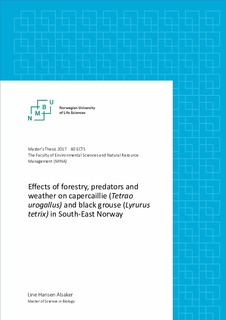| dc.description.abstract | The European populations of capercaillie (Tetrao urogallus) and black grouse (Lyrurus tetrix) have declined the last 50 to 100 years. The decline has happened at the same time as changes in forestry practices, predation pressure and climate, but the specific drivers of the decline are still not clear.
The aim of this thesis was to test the main drivers for population dynamics of the forest grouse species; capercaillie and black grouse. In South-East Norway, over a period of 41 years in Sjøliseterberget (1975-2016) and 19 years in Hobøl (1987-2016), data were collected each autumn by a line transect method. By this method capercaillie and black grouse abundance and reproduction, in addition to habitat (forest age classes) were registered. My main goal was to reveal if the reproduction of forest grouse had changed over time and what the main causes could be. I therefore, specifically tested the habitat preferences of forest grouse, if these habitats had changed during time of study and if the preference of forest grouse had changed accordingly, to establish whether forestry could be affecting the reproduction. In addition, annual drivers of forest grouse reproduction like weather in the summer (“The Weather Hypothesis”) and difference in predation pressure (“The Alternative Prey Hypothesis”) were tested.
I found declining reproduction of capercaillie in Sjøliseterberget and black grouse in Hobøl. While the capercaillie preferred the oldest succession stages of the forest, the black grouse preferred younger forest. The proportion of medium old and old forest did not change in neither area over time, and nor did the forest grouse preferences. The reproduction was thus declining despite a stable age structure of the forest. I further found that temperature in June and differences in fox population from one year to another explained most of the variation in reproduction in Sjøliseterberget based on AICc model selection, while no factors explained the variation in reproduction in Hobøl. Lack of significant results in Hobøl was possibly caused by a smaller sample size. The alternative prey hypothesis was confirmed as a large vole population increased the fox population the next year, and this fox population decreased reproduction of forest grouse. Despite this two-step link between voles and forest grouse, no significant covariation between vole abundance and forest grouse reproduction was detected, even in periods with a high fox population. The weather hypothesis was partially confirmed as increase in temperature in June had a large positive effect on reproduction, while increase in precipitation in the same month did not have a negative effect as first predicted. Further analyses showed that also seasonal NAO affected the reproduction.
This study contributes to the understanding of short-term fluctuations and long-term trends in population dynamics of capercaillie and black grouse. In addition, knowing how forest-dwelling species respond to variation in forestry, predation pressure and weather can help us understand how these species will persist in a future with extensive forestry and a changing climate. | nb_NO |

